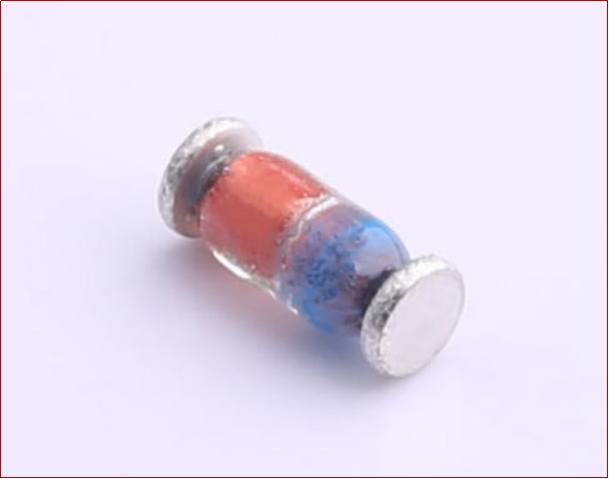Service hotline
+86 0755-83044319
release time:2024-10-11Author source:SlkorBrowse:21368
The ZMM24 zener diode is a widely used component in electronic circuits, primarily functioning to provide stable output voltage, especially in power supply circuits. Understanding its key parameters is crucial to ensure reliability and stability under various operating conditions. Below is a detailed explanation of the key parameters of the ZMM24.

1. Reverse Breakdown Voltage (Vz)
The reverse breakdown voltage is one of the most important parameters of a zener diode, typically maintaining a constant value within the rated range. For the ZMM24, the typical reverse breakdown voltage is 24V. This means that when the reverse voltage applied to the diode reaches 24V, the diode enters breakdown mode, allowing current to flow and maintaining that voltage. At this point, despite fluctuations in input voltage, the output voltage remains relatively stable, which is crucial for protecting subsequent circuits from over-voltage impacts.
2. Temperature Coefficient (TC)
The temperature coefficient describes the rate at which the output voltage changes with temperature variations. For most voltage regulation applications, a smaller temperature coefficient indicates better performance. The temperature coefficient of the ZMM24 is usually around ±2 mV/°C, meaning that the output voltage variation is minimal within the operating temperature range (generally -55°C to +150°C). This characteristic ensures that the ZMM24 maintains stable output voltage even in environments with significant temperature fluctuations, thereby improving the overall reliability of the system.
3. Dynamic Impedance (Zz)
Dynamic impedance refers to the impedance exhibited by the zener diode during operation, specifically the ratio of output voltage change to input current change while in regulation. For the ZMM24, a lower dynamic impedance indicates less sensitivity of the output voltage to changes in input current, meaning it better maintains its voltage regulation characteristics. When dynamic impedance is low, the circuit will not experience significant voltage fluctuations during load changes, ensuring circuit stability.
4. Maximum Power (Pmax)
Maximum power refers to the highest power that the zener diode can withstand under normal operating conditions. In the specifications for the ZMM24, the maximum power is typically 1W. This parameter is critical because applying power beyond this limit may cause the diode to overheat, leading to damage. Therefore, when designing circuits, it is essential to ensure that the product of the applied current and voltage does not exceed this maximum power limit to avoid unexpected failures.
5. Rated Current (Iz)
Rated current is the maximum current value at which the zener diode can safely operate while in a given regulation state. For the ZMM24, the common rated current is 20mA. This means that under stable working conditions, the ZMM24 can handle up to 20mA of current without damage. Selecting an appropriate rated current is crucial for ensuring the long-term reliability of the zener diode. Moreover, in practical applications, it is often recommended to set the operating current between 60% and 80% of the rated current to enhance the diode's lifespan.
Application Cases
The ZMM24 zener diode is commonly used in power management, signal processing, and protection circuits across multiple fields. For example, in power supply circuits, it can serve as a voltage protection device to prevent excessive power supply voltage from damaging subsequent circuits. In sensitive signal processing systems, the ZMM24 can help stabilize signal voltage and reduce interference, thereby improving overall system performance.
Summary
The ZMM24 zener diode is favored by electronic engineers for its excellent performance and wide range of applications. Understanding its key parameters, such as reverse breakdown voltage, temperature coefficient, dynamic impedance, maximum power, and rated current, is essential for designing and implementing stable and reliable circuits. As electronic technology continues to advance, zener diodes will continue to play an important role in supporting the stable operation of various electronic devices.









Site Map | 萨科微 | 金航标 | Slkor | Kinghelm
RU | FR | DE | IT | ES | PT | JA | KO | AR | TR | TH | MS | VI | MG | FA | ZH-TW | HR | BG | SD| GD | SN | SM | PS | LB | KY | KU | HAW | CO | AM | UZ | TG | SU | ST | ML | KK | NY | ZU | YO | TE | TA | SO| PA| NE | MN | MI | LA | LO | KM | KN
| JW | IG | HMN | HA | EO | CEB | BS | BN | UR | HT | KA | EU | AZ | HY | YI |MK | IS | BE | CY | GA | SW | SV | AF | FA | TR | TH | MT | HU | GL | ET | NL | DA | CS | FI | EL | HI | NO | PL | RO | CA | TL | IW | LV | ID | LT | SR | SQ | SL | UK
Copyright ©2015-2025 Shenzhen Slkor Micro Semicon Co., Ltd